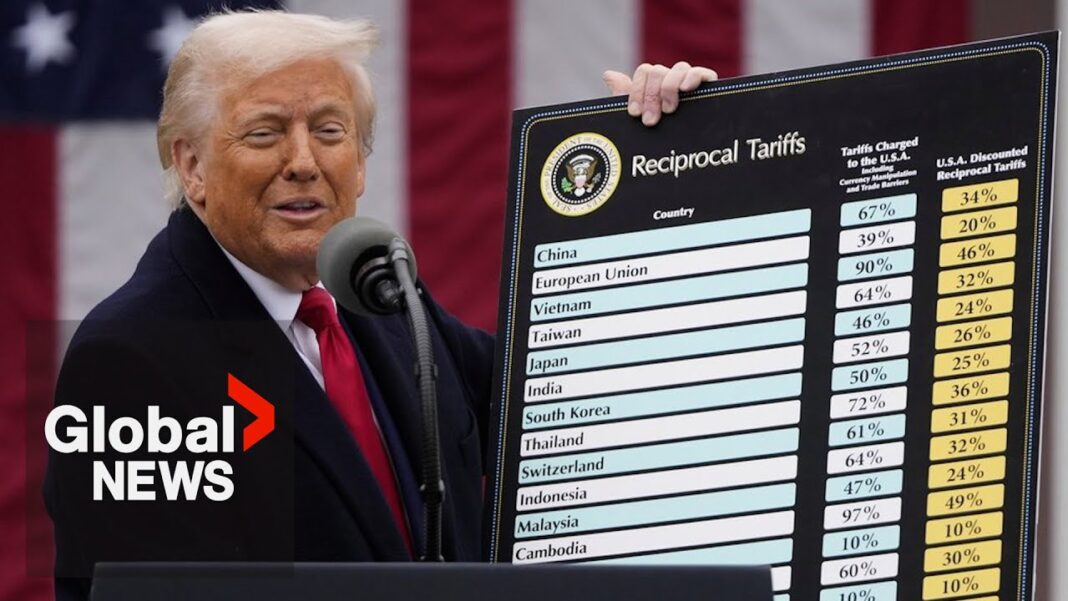|
Getting your Trinity Audio player ready...
|
From Panic to Patriotism: Americans Split Over Trump’s Tariff Tsunami
Edited by: TJVNews.com
President Donald Trump’s bold announcement of universal and “reciprocal” tariffs on imports from countries across the globe has set off a firestorm of criticism from major U.S. business groups, leading economists, trade policy experts, and a number of lawmakers. While some praised the move as a strong pro-worker stance intended to re-industrialize the American economy, others issued stark warnings about its potential to raise consumer prices, disrupt supply chains, and weaken economic growth.
According to a report that appeared on Wednesday in The New York Times, the tariffs — targeting major trading partners such as China, the European Union, Japan, and India — will significantly raise the cost of imported goods for American businesses and consumers alike. The policy represents one of the most aggressive trade actions in recent U.S. history and is expected to affect a vast swath of goods ranging from electronics and industrial parts to clothing, footwear, and food products.
The immediate response from industry groups has been one of deep concern. As reported by The New York Times, Matt Priest, president and CEO of the Footwear Distributors and Retailers of America, did not mince words: “This is catastrophic for American families.” Priest emphasized that the tariffs will drive up retail costs, reduce product quality, and sow uncertainty throughout the supply chain. “We had hoped the president would take a more targeted approach,” he added, “but these broad tariffs will only weaken consumer confidence.”
Echoing this sentiment, the National Retail Federation (NRF) stressed that tariffs are not paid by foreign producers — but by U.S. importers, who must pass those costs on to consumers. In a sharply worded statement cited by The New York Times, the NRF said the policy would bring “more anxiety and uncertainty for American businesses and consumers,” and warned that the immediate implementation of such sweeping tariffs leaves little time for U.S. companies to prepare.
The National Restaurant Association added its voice to the growing chorus of critics. According to The New York Times report, the group warned that tariffs on imported food products and packaging materials would hike operational costs for restaurants already facing labor shortages and volatile supply chains.
“Many restaurant operators source as many domestic ingredients as they can,” said Michelle Korsmo, the association’s president, “but it’s simply not possible for U.S. farmers and ranchers to produce the volumes needed to support consumer demand.” She cautioned that the tariffs would push menu prices higher and add to the uncertainty that business owners are already struggling to manage.
Meanwhile, the National Association of Manufacturers (NAM) adopted a more measured tone, though no less wary. According to the report in The New York Times, Jay Timmons, the group’s president, stated that NAM was still reviewing the details of the new tariff structure, but warned that such sweeping trade barriers could “threaten investment, jobs, supply chains, and, in turn, America’s ability to outcompete other nations and lead as the pre-eminent manufacturing superpower.”
Not all responses were negative. As reported iny The New York Times, Nick Iacovella, executive vice president at the Coalition for a Prosperous America, praised Trump’s decision as a monumental turning point for U.S. trade policy. “Today is arguably the single greatest trade and economic policy action in the history of the country,” he declared, claiming the tariffs would “cement President Trump’s legacy” by laying the groundwork for a “new golden age of economic production and prosperity.”
Iacovella and like-minded proponents believe the move will force U.S. corporations to rebuild domestic manufacturing capacity and create working-class jobs, reversing decades of industrial decline. They see the tariffs not as protectionism, but as economic rebalancing in the face of foreign trade manipulation and unfair subsidies.
President Trump has brushed aside criticism of his tariff policies, insisting that “experts have been wrong all along” and that fears of economic harm are misplaced. He reiterated his belief that reciprocal tariffs — matching the import duties that other countries impose on U.S. goods — are both fair and necessary, as per the report in The New York Times.
However, critics argue that such a policy misunderstands the nature of modern trade and will result in retaliatory tariffs, lost export markets, and higher inflation.
According to information provided in The New York Times report, the tariffs—framed by Trump as “reciprocal” measures designed to punish foreign countries for their protectionist practices—represent one of the most ambitious trade overhauls since the Smoot-Hawley Tariff Act of 1930, a policy widely blamed for worsening the Great Depression.
In a joint statement quoted by The New York Times, Scott Lincicome and Colin Grabow of the Cato Institute, a libertarian think tank known for its free-market philosophy, called Trump’s justifications for the tariffs both “flimsy” and “contradictory.” They warned that his proposals would raise consumer prices, disrupt supply chains, and trigger international retaliation, potentially plunging the global economy into instability.
“With today’s announcement, U.S. tariffs will approach levels not seen since the Smoot-Hawley Tariff Act,” Lincicome and Grabow stated, “which incited a global trade war and deepened the Great Depression.”
Economic forecasters across Wall Street have already begun revising their outlooks downward, according to the report in The New York Times. Nancy Lazar, chief global economist at Piper Sandler, now predicts a 1% contraction in U.S. economic growth in Q2—a full percentage point below her previous expectations.
“This is an immediate hit to the economy,” Lazar told The New York Times. “You’re going to be increasing prices more aggressively, and it’s going to negatively impact the consumer space more than we had anticipated.”
James Knightley, chief international economist at ING, echoed that warning, predicting the tariffs would “squeeze spending power” and damage corporate profit margins. “That’s why you are seeing all of us revising down our growth forecasts,” Knightley explained to The New York Times.
Despite the widespread concern, Federal Reserve Governor Adriana Kugler downplayed fears of imminent stagflation—a toxic mix of inflation and economic stagnation. Speaking at Princeton University, Kugler admitted to seeing “upside risks to inflation” and signs of a potential slowdown but argued that the U.S. economy remained fundamentally resilient.
According to figures provided by Exiger, a firm that specializes in supply chain analysis and was cited in The New York Times report, Trump’s new tariffs could amount to $600 billion in new levies—the brunt of which would fall on just ten countries.
The hardest hit would be China at $149 billion, Vietnam at $63 billion, Taiwan at $37 billion, Japan at $36 billion and Germany and Ireland combined at $41 billion, as was detailed in the report,
Exiger characterized Trump’s policy as a “monumental shift” that will reshape not only global sourcing and pricing but also geopolitical alliances and corporate strategy.
On Capitol Hill, the reaction has fallen largely along partisan lines, though even some Republicans have expressed concern about unintended consequences.
Senator Ron Wyden, a top Democrat from Oregon, lambasted the proposal. “Trump’s shortsighted tariff plan won’t rebuild American manufacturing or help working families get ahead,” he said in comments to The New York Times. “It’s a tax on almost everything families buy, so Trump can give his billionaire friends a tax cut.”
Representative Jason Smith, Republican chairman of the House Ways and Means Committee, praised the measure as a lever of economic diplomacy, saying the tariffs would help “create a level playing field for American farmers, producers, and workers.”
Some industry leaders cheered the move, calling it long overdue. Kevin Dempsey, president of the American Iron and Steel Institute, thanked Trump for “standing up for American workers” who have long suffered from foreign dumping and unfair competition, The New York Times report said.
John Williams, executive director of the Southern Shrimp Alliance, also applauded the action. “We’ve watched as multigenerational family businesses tie up their boats, unable to compete with foreign producers who play by a completely different set of rules,” he told The New York Times. “We are grateful for the Trump administration’s actions today, which will preserve American jobs, food security and our commitment to ethical production.”
Trump’s tariff policy speaks volumes about his broader economic vision: aggressive protectionism aimed at restoring domestic industry, even at the risk of economic friction with allies and higher costs for consumers.
But as The New York Times reported, that approach carries enormous risks. With inflation still a top concern for American households and global supply chains already fragile, many fear that Trump’s tariff blitz may bring more economic pain than prosperity.






When gasoline prices went through the roof, many leftists organizations were happy. Now people have an incentive to turn to green energy like solar. Why not say the same thing here? With tariffs – maybe people will turn to products made in America.